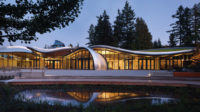|
One of the country’s oldest architecture firms has teamed with one of its youngest, betting on expansion while other practices scale back.
In early December, Shepley Bulfinch Richardson & Abbott, which was founded by H.H. Richardson in 1874, acquired Merzproject of Phoenix, Arizona, which formed in 2004.
The young firm, which will remain in Phoenix with its two principals intact, will also retain its name, with a slight twist; it will now be known as “Merzproject, a studio of Shepley Bulfinch.”
In 2008, Shepley Bulfinch reportedly earned $36.6 million in architectural revenues and ranked No. 89 on Architectural Record’s list of the top 250 U.S. firms. Merzproject, with just eight employees, can tap its parent company’s resources, like, say, publicists and accountants, says principal Joe Herzog, AIA, who did not disclose the deal’s terms.
More significantly, though, Herzog’s fledgling practice, which Architectural Record named as a Design Vanguard firm this month, in a nod to its budding talent, may now have a better shot at larger and more varied commissions. As Herzog explains: “Unfortunately in America there is an obsession with, ‘Have you done a building type 40 times before?’ And if even you have, they may short-list you.”
For Shepley Bulfinch, whose 130 employees are based in a single Boston office, meanwhile, the merger lands it a key beachhead in the Southwest, which should be a growth area once the current recession eases, says president Carole Wedge, FAIA.
In the expansion, Wedge’s firm can afford to be so counter-cyclical because it’s weathered the downturn with relatively safe university and hospital projects, she adds, rather than the riskier housing and Dubai-related ventures that doomed some of its peers.
“We weren’t flying as high as some of those folks,” says Wedge of her firm, whose portfolio includes 120 projects at Harvard, plus many other Ivy League schools. “But now we can sow seeds for the future.”
So far, the first project for the combined firms—the conversion of a 1980s mirrored-glass midrise office building into a 12,000-square-foot clinic for the Southwest College of Naturopathic Medicine and Health Sciences, in Tempe—seems to play to Shepley Bulfinch’s healthcare strengths.
But the large East Coast firm may have a chance at less-traditional undertakings if it follows the lead of Merzproject, known for more modern, smaller-scale projects. Its portfolio includes the Galleries at Turney, a series of LEED-certified modular-style homes in Scottsdale, or After Hours, a mixed-use art studio, wine cellar, and residence in central Phoenix.
And that divergence in subject and style might win Richardson’s approval. “He was an innovator who pushed the envelope,” Wedge says, “and I think we are doing that, too.”




Post a comment to this article
Report Abusive Comment